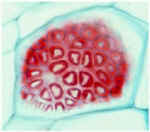| Secondary Phloem is produced by the Vascular
Cambium and can form a continuous cylinder of tissue opposite secondary xylem in
woody plants. It is a complex tissue which contains Sieve Elements.
Sieve Cells (SC) are characteristic for Gymnosperms,
while Angiosperms produce Sieve Tube
Members (STM). The latter form Sieve Tubes when joined
end to end. Sieve Tube Members have Sieve Plates on their end
walls. These contain large Sieve Pores. Sieve Pores are also
present on the lateral walls of Sieve Tube Members. Sieve Cells do
not have Sieve Plates but only have Sieve Pores. These may be more concentrated
where they overlap with other Sieve Cells but they do not have Sieve Plates. Sieve Cells
are generally longer than STM and are generally smaller in diameter. |
 |
A Sieve Plate with large Sieve Pores |
| Companion Cells are derived from the same
cell which forms a Sieve Tube Member. They control the
physiological processes involved in phloem transport. Albuminous
Cells perform a similar function for Sieve Cells.
However, they are not a direct descendent of the cell which produces the Sieve Cell.
Companion Cells and Albuminous Cells resemble Parenchyma cells. Furthermore, Parenchyma cells are also present in Secondary Phloem.
Consequently, it is sometimes difficult to distinguish Companion Cells and
Albuminous Cells from Phloem Parenchyma. |
| Finally,
Secondary Phloem may contain Fibers. These may occur as
individual cells scattered in the Phloem or they may occur in clusters or layers. Fibers
help to strengthen the Phloem and can protect its thin-walled cells from the pressure
which develops from secondary growth. We will start with
gymnosperm phloem and proceed to angiosperm phloem. |